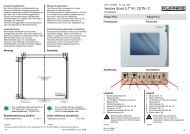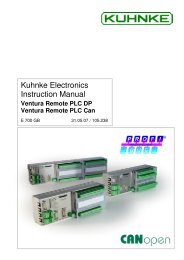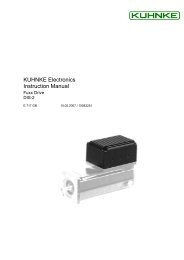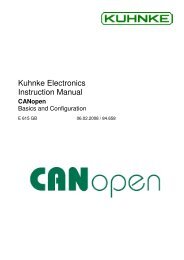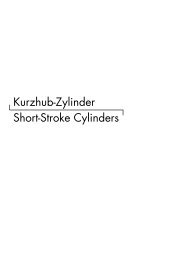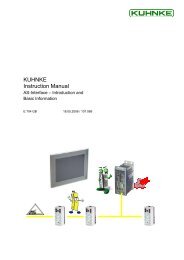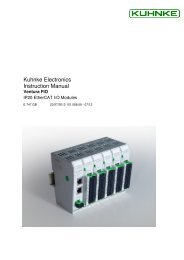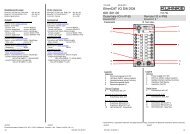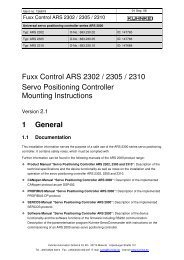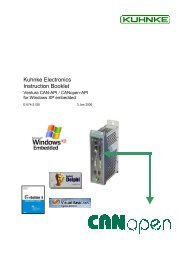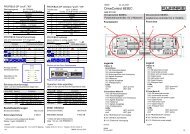Fuxx Control - ARS 2320 / ARS 2340 Instruction Manual - Kuhnke
Fuxx Control - ARS 2320 / ARS 2340 Instruction Manual - Kuhnke
Fuxx Control - ARS 2320 / ARS 2340 Instruction Manual - Kuhnke
You also want an ePaper? Increase the reach of your titles
YUMPU automatically turns print PDFs into web optimized ePapers that Google loves.
KUHNKE Automation <strong>Fuxx</strong> <strong>Control</strong> <strong>ARS</strong> <strong>2320</strong> / <strong>ARS</strong> <strong>2340</strong><br />
5.2.5 Speed-controlled mode<br />
This operating mode is used when the motor speed has to be kept constant regardless of the active<br />
load. The motor speed exactly follows the speed specified by the setpoint management system.<br />
With the factory setting of the <strong>ARS</strong> 2300 servo positioning controller, the cycle time of the speed<br />
control circuit is twice the PWM period, thus typically 200µs. However, it can also be set as an integer<br />
multiple of the current controller cycle time.<br />
The speed controller is a PI-controller and has an internal resolution of 12 bits per rpm. In order to<br />
eliminate wind-up effects, the integrator function is stopped when underlying limits are reached.<br />
In speed control mode, the current controllers and the speed controller are active. If the setpoint is set<br />
via analog setpoint inputs, a "safe zero" can be defined as an option. If the analog setpoint is in this<br />
range, the setpoint is set to zero ("dead zone"). Thus interferences or offset drifts can be suppressed.<br />
The function of a dead zone can be activated and deactivated and its range can be adjusted.<br />
The motor-internal encoder system, which is also used for commutation, determines the actual speed<br />
and the actual position. For the actual value feedback to the speed control system, all encoder<br />
interfaces can be equally selected (e.g. reference encoder or a corresponding system at the external<br />
incremental encoder input). The actual speed value for the speed controller can be fed back via the<br />
external incremental encoder input, for instance.<br />
The speed setpoint can be set internally or derived from the data of an external encoder system<br />
(speed synchronization via [X10] for the speed controller).<br />
It is also possible to use setpoints of an MDC program (Drive <strong>Control</strong>).<br />
5.2.6 Torque-limited speed control<br />
<strong>ARS</strong> 2300 servo positioning controllers support torque-limited speed-controlled operation with the<br />
following characteristic features:<br />
� Fast updating of the limit value, e.g. in a 200 µs cycle<br />
� Addition of two limitation sources (e.g. for feedforward values)<br />
5.2.7 Synchronization with external clock sources<br />
The controllers operate with sinusoidal constrained current. The cycle time is always linked with the<br />
PWM frequency. In order to synchronize the device control system with external clock sources (e.g.<br />
SERCOS, PROFIBUS MC), the device is equipped with a corresponding PLL. In these cases, the<br />
cycle time is variable within certain limits in order to allow synchronization with the external clock<br />
signal. For synchronization with external clock sources, the user has to indicate the nominal<br />
synchronous cycle time.<br />
E 732 GB 47<br />
14.12.2006



